
2016
tekst i zdjęcia: Wojciech Dąbrowski © - text & photos
Returning from the interesting expeditions I always try to write a travel report - to share my updated knowledge and to help other travelers in their preparations to the voyage. A lot of such reports you can already see on my website - sorry - most of them in Polish only. New reports require work and time. Unfortunately it is now harder and harder for me to find the time. On this page you will see some interesting pictures from the last years. They are waiting to be used in the coming reports. I hope to write them someday...
Po powrocie z każdej ciekawej podróży staram się napisać ilustrowany raport, by podzielić się moją świeżo zdobytą wiedzą i w ten sposób pomóc innym podróżnikom w ich przygotowaniach do wyjazdów. Wiele takich raportów znajdziecie już na moich stronach. Niestety pisanie tych raportów to praca pochłaniająca sporo cennego czasu. Nie zawsze mogę znaleźć ten czas... Na tej stronie znajdziecie co ciekawsze zdjęcia do tematów, które czekają na przygotowanie raportów. Mam nadzieje, że kiedyś doczekają się one osobnych stron... Niektóre już się doczekały...
In mid-March 2016 I came back from another great trip. This time it was lasting 2.5 months expedition to Asia and Australia. The map with the route you can see here. At the beginning of the trip three aircraft one by one moved me through Istanbul and Kuala Lumpur to Perth in Western Australia. It's a nice town. Since my last visit more elegant high-rises appeared there:
W połowie marca 2016 wróciłem z kolejnej wielkiej podróży. Tym razem była to trwająca 2,5 miesiąca ekspedycja do Azji i Australii. Jej mapę zobaczyć możecie tutaj. Na początek trzy kolejne samoloty przeniosły mnie przez Istambuł i Kuala Lumpur do Perth w Zachodniej Australii. To ładne miasto. Od czasu mojego ostatniego pobytu przybyło w nim eleganckich wieżowców:
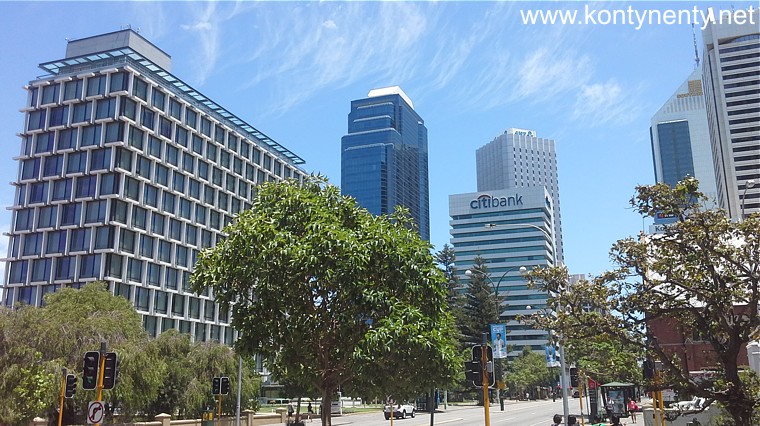
In Perth, living in a youth hostel, I tried to adapt quickly to the different time zone and the rapid climate change. I also photographed (bronze) kangaroos hopping along the sidewalks of the downtown :)
W Perth, mieszkając w schronisku młodzieżowym starałem się szybko przystosować do innej strefy czasowej i do gwałtownej zmiany klimatu. Fotografowałem też (spiżowe) kangury skaczące po chodnikach śródmieścia :)
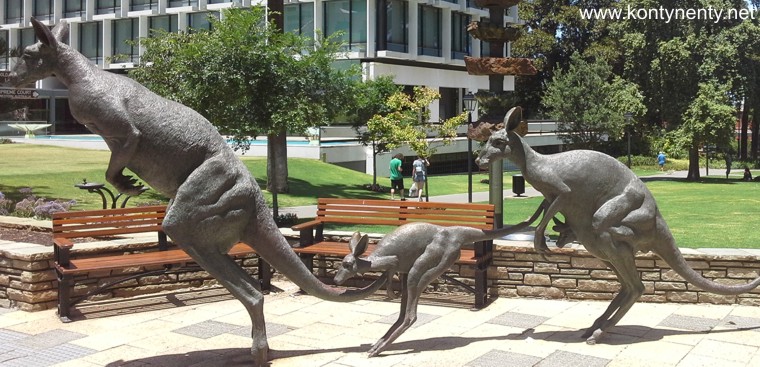
A real adventure began in Perth with 9-day expedition through the Nullarbor desert, where I slept under the stars. Nullarbor was for me probably the last unknown region of Australia. On the first day we got to Wave Rock - the peculiar bent of rock piled up like a wave:
W Perth zaczęła się prawdziwa przygoda: 9-dniowa ekspedycja przez Pustynię Nullarbor, ze spaniem pod gwiazdami. Nullarbor był dla mnie chyba ostatnim nieznanym wcześniej regionem Australii. Pierwszego dnia dotarliśmy do Wave Rock - osobliwej skały wygiętej jak spiętrzona fala:
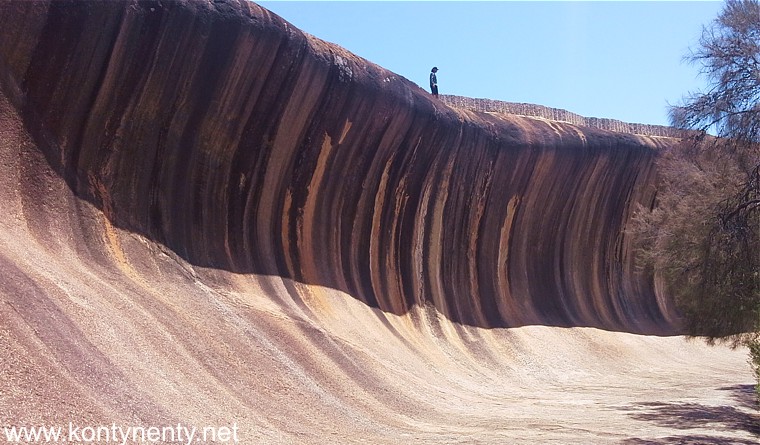
For the whole trip we had about 2000 kilometers to cover. Here, at the beginning it is along the highway grew a lot of green eucalyptus. The farther, the landscape became drier and austere.
Do celu podróży, którym była stolica Południowej Australii - Adelajda, mieliśmy około 2000 kilometrów. Tu jeszcze wzdłuż szosy rosło sporo zielonych eukaliptusów. Im dalej, tym krajobraz stawał się bardziej suchy i surowy.
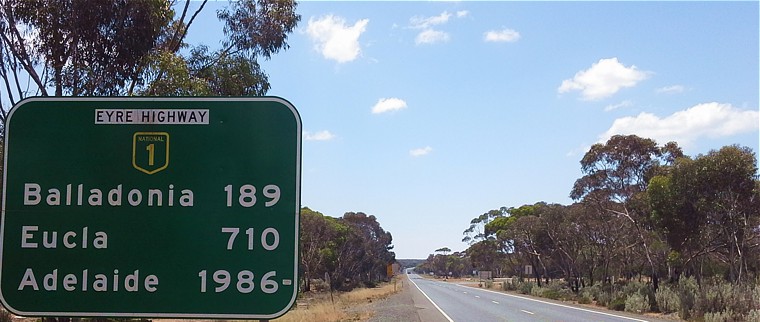
It turned out that the anhydrous, monotonous and dotted only with dry bushes desert with its southern side abuts the ocean. And it is on the coast, where you can admire the most interesting landscapes. At the beginning there are still plenty of greenery - this is around the town of Esperance:
Okazało się, że bezwodna, monotonna i usiana suchymi krzakami pustynia swoim południowym bokiem opiera się o ocean. I to właśnie na wybrzeżu można podziwiać jej najciekawsze krajobrazy. Na początku jest jeszcze sporo zieleni - oto okolice miasteczka Esperance:
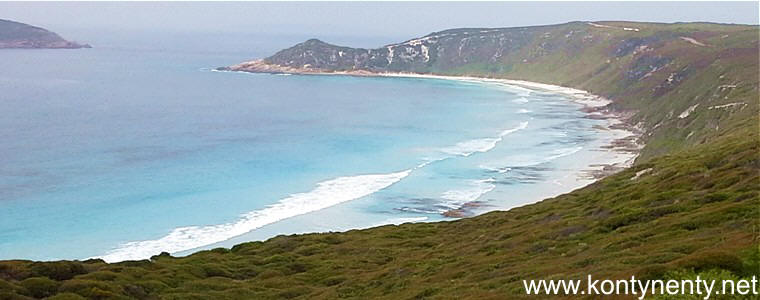
In the immediate vicinity of the coast are piling up here huge granite rock monoliths. One of them - the Frenchmen's Peak I climbed successfully. Looking at the bottom you can see an interesting tip in the shape of a giant hat. Nobody guesses that under the "hat" is a big cave, which can accommodate up to 50 people:
W bezpośrednim sąsiedztwie wybrzeża piętrzą się tutaj granitowe skalne monolity. Na jeden z nich - Frenchmen's Peak wspinałem się z powodzeniem. Patrząc z dołu można dostrzec ciekawy wierzchołek w kształcie gigantycznego beretu. Nikt nie domyśla się, że pod "beretem" jest wielka grota, mogąca pomieścić nawet 50 osób:
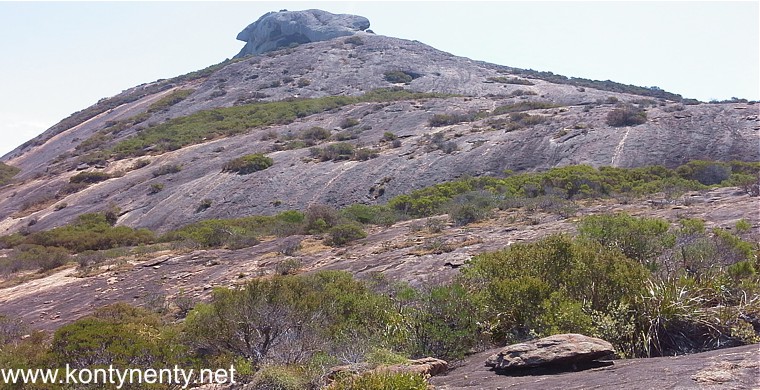
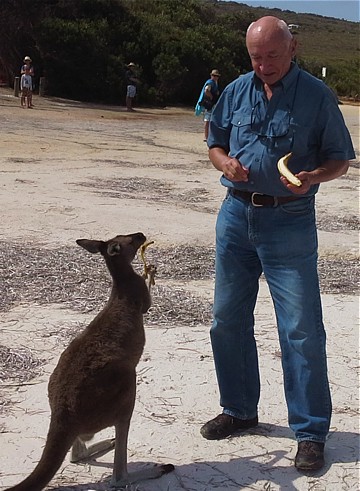
Jeszcze tego samego dnia pod wieczór dotarliśmy do idyllicznej zatoki Lucky Bay w Parku Narodowym Cape Le Grand. Poza turkusowym oceanem i kilkukilometrową plażą o piasku białym jak puder wielką atrakcją tego miejsca są przyzwyczajone do obecności człowieka kangury. Można je fotografować, a nawet karmić z ręki skórkami od bananów...
Later that same day in the evening we arrived to the idyllic Lucky Bay in the Cape Le Grand National Park. Besides the turquoise ocean and several kilometers of beach with white, powder sand the great attraction of this place are kangaroos accustomed to human presence. They can be photographed, and even feed from the hand of banana skins...
The highway running hundreds of kilometers to the east is not routed close to the sea shore. You have to bounce from it a few or even several kilometers to be able to admire the high and dramatic cliffs:
Szosa biegnąca setkami kilometrów na wschód nie jest wcale poprowadzona w pobliżu morskiego brzegu, co może zaskoczyć, a nawet rozczarować podróżnika. Trzeba odbić od niej kilka, a nawet kilkanaście kilometrów, by móc podziwiać wysokie i dramatyczne klify:
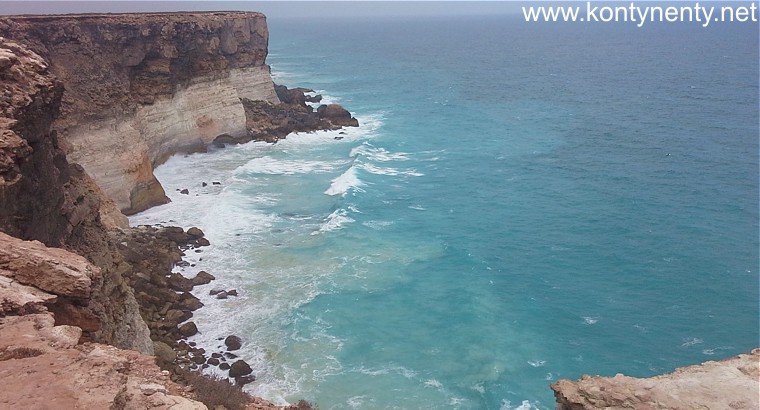
In other places the rocky coast was low and we could take a close look how high the billows of rage crashing on the red rocks shore:
W innych miejscach skaliste wybrzeże było niskie i mogliśmy z bliska patrzeć, jak wysokie bałwany z wściekłością rozbijają się o czerwone głazy brzegu:
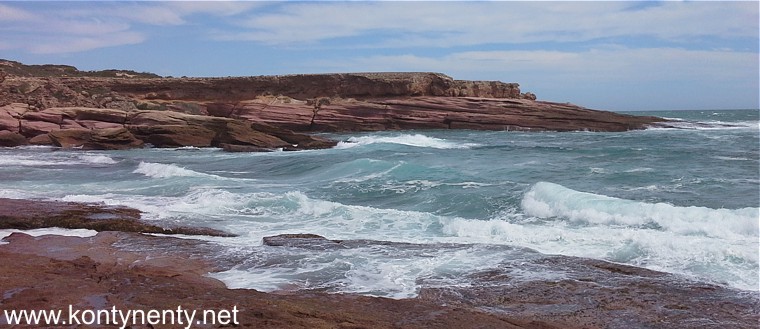
The sandy dunes were also on our trail. We visited the ruins of the old telegraph station partially buried by sand:
Piaszczyste diuny także były na naszym szlaku. Zwiedzaliśmy ruiny dawnej stacji telegrafu częściowo zasypane przez piasek:
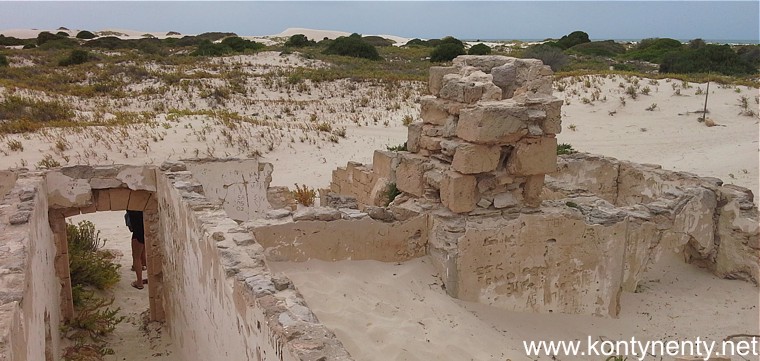
When at last the desert ended, we turned south - to put forward in the ocean Eyre Peninsula. Somewhere at the end we found Mikkira Station - a large farm on the territory of which live in natural conditions, koalas and kangaroos. Funny bears are not shy and you can approach them very close. I confess to you that it was the place for me was the biggest attraction of the whole expedition:
Gdy w końcu pustynia się skończyła, skręciliśmy na południe - na wysunięty w ocean półwysep Eyre. Gdzieś na jego krańcu odnajdujemy Mikkira Station - dużą farmę na terenie której mieszkają w naturalnych warunkach misie koala i kangury. Misie wcale nie są płochliwe i można podejść do nich bardzo blisko. Wyznam Wam, że to właśnie miejsce było dla mnie największą atrakcją całej ekspedycji:
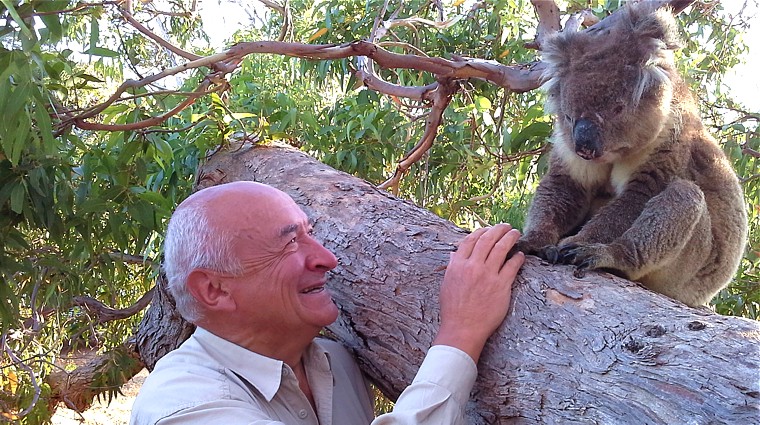
The expedition ended in Adelaide, I boarded there the plane to fly to Brisbane, where it was nice to meet after years my friends: Ala and Waldek. We used one day for an interesting excursion to Bald Rock - a giant rock monolith jutting over the endless, green subtropical forest:
Ekspedycja skończyła się w Adelajdzie, skąd poleciałem do Brisbane, gdzie miło mi było spotkać po latach mieszkających tam przyjaciół: Alę i Waldka. Jeden dzień wykorzystaliśmy na wspólną wyprawę do Bald Rock - gigantycznego skalnego monolitu wyrastającego na 200 metrów ponad bezkresną zieleń podzwrotnikowego lasu:
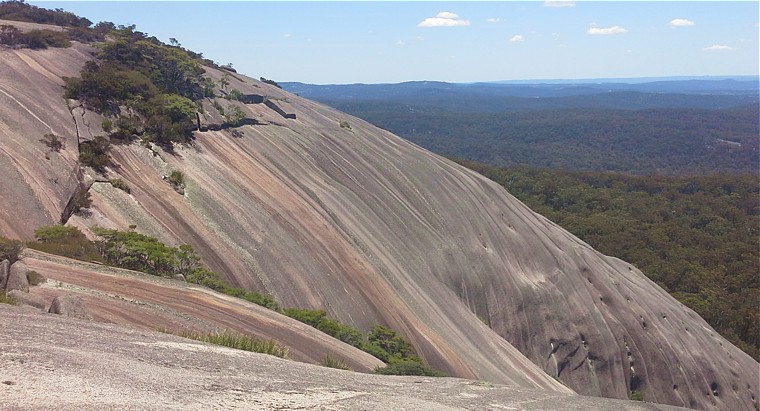
In Brisbane I embarked the ship sailing to the islands of Papua and Solomons. Cruise gave me the opportunity to reach the rarely visited islands, which can not be reached by plane (not to mention the high cost of flying). We started from Milne Bay in Papua. It was a new contact with great exotic and humid tropical climate. Landing on the islands usually held using tenders - large, covered motor boats.
W Brisbane zaokrętowałem się na statek, płynący ku wyspom Papui i Salomona. Rejs dawał możliwość dotarcia do rzadko odwiedzanych wysp, na które nie sposób dotrzeć samolotem (nie wspominając nawet o kosmicznych kosztach takiej lotniczej eskapady). Zaczęliśmy od Milne Bay na Papui. To było ponowne zetkniecie się z wielką egzotyką i wilgotnym, tropikalnym klimatem. Lądowania na wyspach zazwyczaj odbywały się przy wykorzystaniu tenderów - dużych, krytych motorówek.
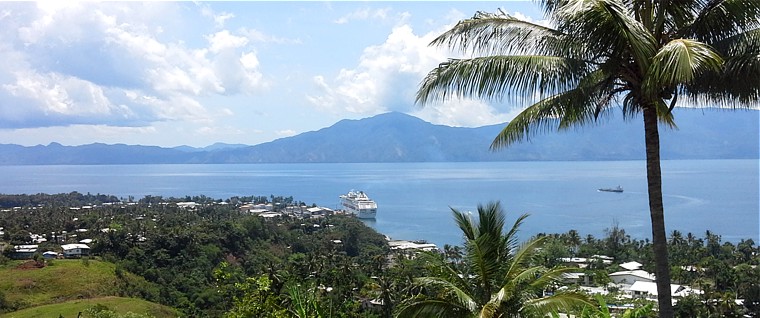
Then we visited in turn two islands in the archipelago of Trobriands. These beautiful islands, called the Islands of Love look now much different than in the times of famous Polish ethnographer Bronislaw Malinowski. But you can still admire there the manifestations of traditional customs and interesting folklore:
Potem odwiedziliśmy kolejno dwie wyspy w archipelagu Trobriandów. Te piękne wyspy, nazywane Wyspami Miłości teraz wyglądają już inaczej niż w czasach Bronisława Malinowskiego, ale wciąż podziwiać tam można przejawy tradycyjnej obyczajowości i ciekawy folklor:
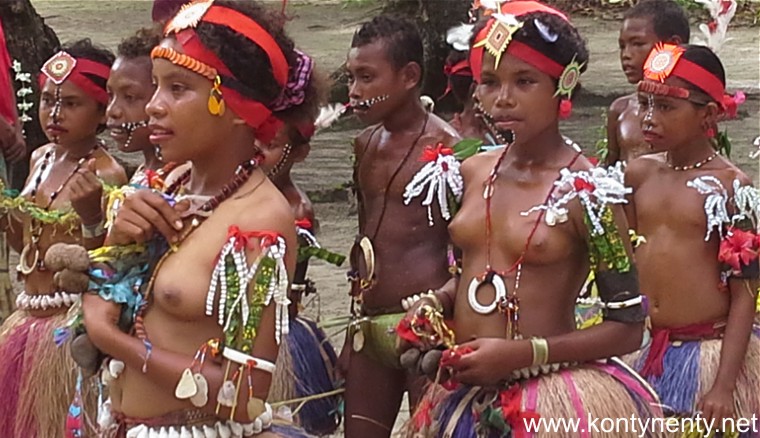
I was exploring the islands on foot, which was not easy considering the difficult climate for Europeans. The prize was the opportunity for direct contact with people and to enjoy the magnificent nature:
Wyspy zwiedzałem na piechotę, co nie było wcale łatwe biorąc pod uwagę trudny dla Europejczyka klimat. Nagrodą była możliwość bezpośredniego kontaktu z ludźmi i podziwiania wspaniałej przyrody:
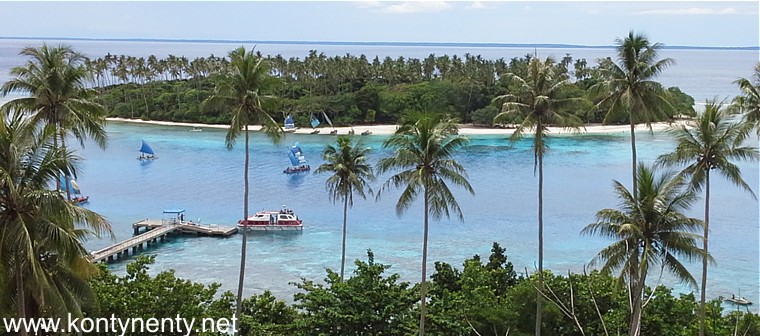
On the New Britain we visited the port of Rabaul, which in 1994 was buried under ashes thrown from the volcano, which grows at the entrance to the bay. Today the volcano lies dormant (closely watched), and the brave (and rich) tourists can go with a guide to the edge of its crater. At the hot springs, where the trek to the volcano begins locals sell souvenirs:
Na Nowej Brytanii zawinęliśmy do portu Rabaul, który w 1994 roku zasypany został popiołami wyrzuconymi z wulkanu, wyrastającego u wejścia do zatoki. Dziś wulkan drzemie (pilnie obserwowany), a odważniejsi (i zasobniejsi) turyści mogą wejść z przewodnikiem na krawędź jego krateru. Przy gorących źródłach, gdzie zaczyna się szlak na wulkan miejscowi sprzedają pamiątki:
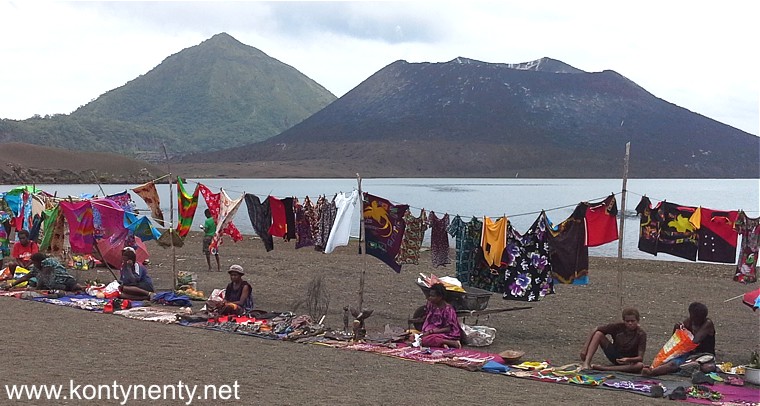
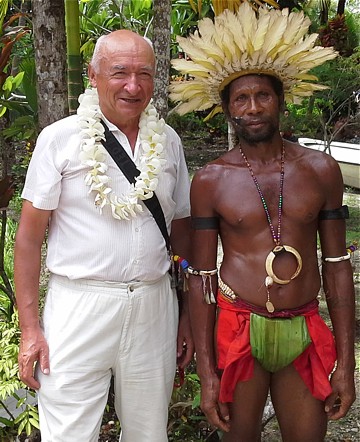
Na końcu naszej trasy była jeszcze Honiara na Wyspach Salomona i Port Vila na Vanuatu, skąd wybrałem się do interioru, by odwiedzić "custom villages" - wioski, gdzie życie toczy się jak niegdyś. zdarzało się, że przybyszów z innego świata witano wieńcami z kwiatów frangipani.
At the end of our journey we were still Honiara in the Solomon Islands and Port Vila on Vanuatu, where I went to the interior to visit the "custom villages" - the village where life goes on as in the past. it happened that visitors from another world were greeted with garlands of flowers frangipani.
After two weeks of exploring the islands from the ship returned to Brisbane
and changed the means of transport to go on a car trip to the hot interior
of Australia. Small blue car - Mitsubishi ASX passed a difficult exam - see
the picture below:
Gdy po dwóch tygodniach eksplorowania wysp ze statku wróciłem do Brisbane i zmieniłem środek transportu, by wyruszyć na samochodową wyprawę do gorącego wnętrza Australii. Mały, niebieski samochodzik - mitsubishi ASX zdał trudny egzamin:
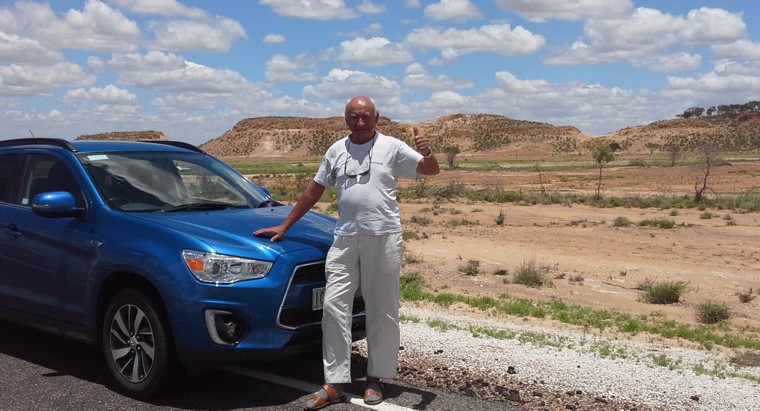
Somewhere in the middle of the entire route, again after 30 years, I looked at the legendary Ayers Rock. That's how it looks from a distance at sunrise time:
Gdzieś w połowie całej trasy ponownie po 30 latach popatrzyłem na legendarny Ayers Rock. Tak prezentował się z daleka o wschodzie słońca:

But on the route of up to 9,000 kilometers long admired also a completely new places and new landscapes. Here, for example are Devils Marbles - huge rocks, having up to 5 meters in diameter, strangely shaped by the nature:
Ale na trasie sięgającej 9000 kilometrów podziwiałem też zupełnie nowe miejsca i nowe krajobrazy. Oto na przykład Devils Marbles - przedziwnie uformowane przez naturę głazy, mające do 5 metrów średnicy:
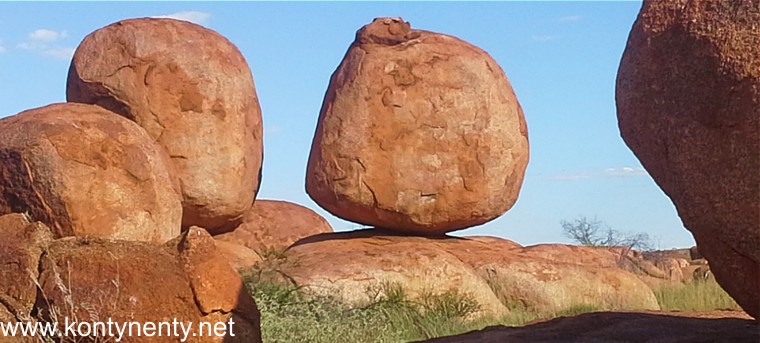
From Australia via Indochina I was going on cheap Air Asia flights to the "vestibule of the Tibet" - how I call the western parts of Sichuan and Yunnan, where there is still much of Tibetan culture. And just there I expect to see those mythical Shangri-La from the "Lost Horizon" story. This was another challenge because of the altitude excising 4,000 meters and the prevailing cold weather there.
A separate report from the region I posted here: Shangri La
Z Australii przez Indochiny poleciałem tanimi liniami Air Asia do Wschodniego Przedsionka Tybetu - tak nazwałem zachodnie krańce Syczuanu i Yunnanu, gdzie wciąż żywa jest tybetańska kultura. No i tam właśnie podróżnicy odnaleźć mogą to mityczne miasto Shangri-La, znane z powieści i filmu "Zagubiony horyzont". To było dla mnie kolejne wyzwanie ze względu na wysokości przekraczające 4000 metrów i panujące tam chłody. Wspaniałe widoki ośnieżonych szczytów nagrodziły mi trudy podróży.
Osobną relację z tego regionu zamieściłem już tutaj: Shangri La
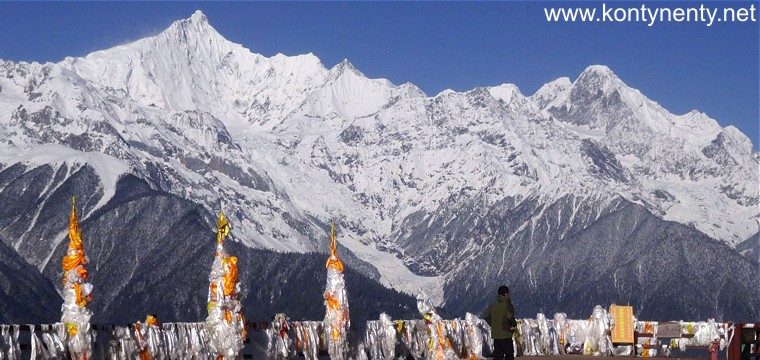
And then, when I was already on he slightly lower level I wandered the famous Tiger Leaping Gorge. It is for sure one of the most interesting gorges in the world. Above the gorge rise rock walls having height up to two thousand meters. It really is impressive:
A gdy znalazłem się potem już nieco niżej powędrowałem słynnym Wąwozem Skaczącego Tygrysa. o na pewno jeden z najbardziej imponujących wąwozów świata. Ponad wąwozem wznoszą się skalne ściany mające do dwóch tysięcy metrów wysokości. To naprawdę robi wrażenie:
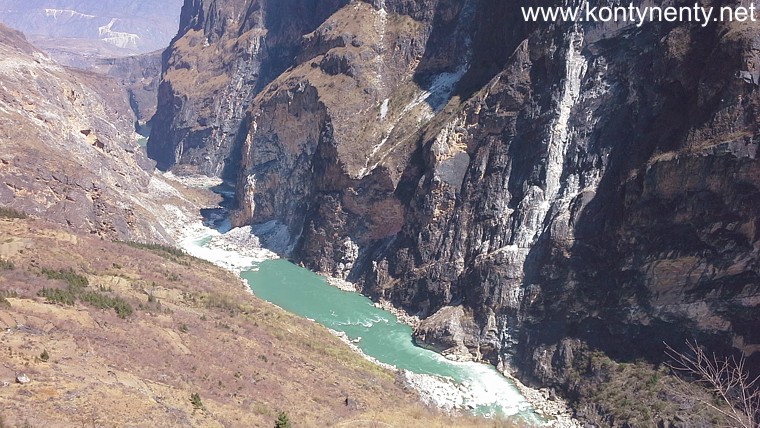
The gorge is visited by crowds of Chinese people, but the excursion coaches set down their only 1/3 of the length of the canyon, where they built a large parking lot and going down the stairs to the river. The entire canyon is over 20 kilometers long and mountain road runs in it (high above the river). I was walking on foot to the end. It was worth - the landscape had been here less dramatic, but still interesting:
Wąwóz jest tłumnie odwiedzany przez Chińczyków, ale wycieczkowe autokary dowożą ich tylko do 1/3 długości kanionu, gdzie zbudowano duży parking i zejście schodami nad rzekę - do pomnika tygrysa. Cały kanion ma zaś ponad 20 kilometrów długości i biegnie nim (wysoko ponad rzeką) górska droga. Dotarłem pieszo aż do jego krańca. Warto było - krajobraz był tu już mniej dramatyczny, ale wciąż ciekawy:
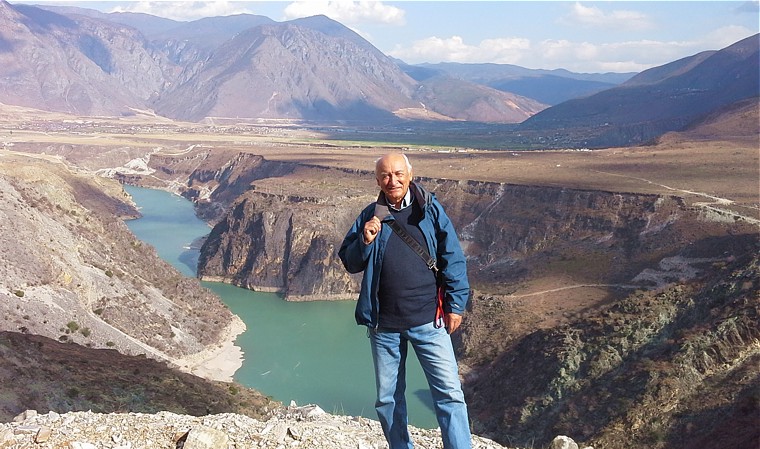
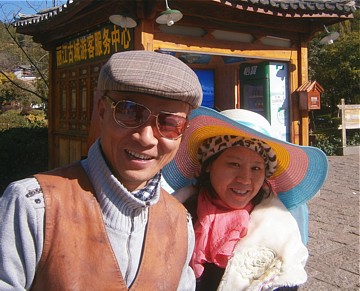
Z Wąwozu Skaczącego Tygrysa zjechałem jeszcze niżej - do zabytkowego miasta Lijiang. Mieszkałem tam w stylowym chińskim domu przerobionym na mini-pensjonat. "Cherry Inn" prowadzą Julia i David - bardzo ciekawi i ogromnie sympatyczni ludzie. To oni zawieźli mnie do wzniesionej z drewna i kamienia tradycyjnej wioski u stóp ośnieżonych szczytów (zdjęcie poniżej). Jest to mało znane miejsce, do którego sam bym zapewne nie dotarł. Dziękuję, drodzy przyjaciele!
From Tiger Leaping Gorge I went even lower - to the historic city of Lijiang. I lived there in a stylish Chinese home converted into a mini-pension. "Cherry Inn" is owned by Julia and David - a very interesting and very friendly people. They drove me to the built of wood and stone traditional village at the foot of the snowy Yulong peak (picture below). It is a little known place that I'd probably never reached it by myself. Thank you, dear friends!
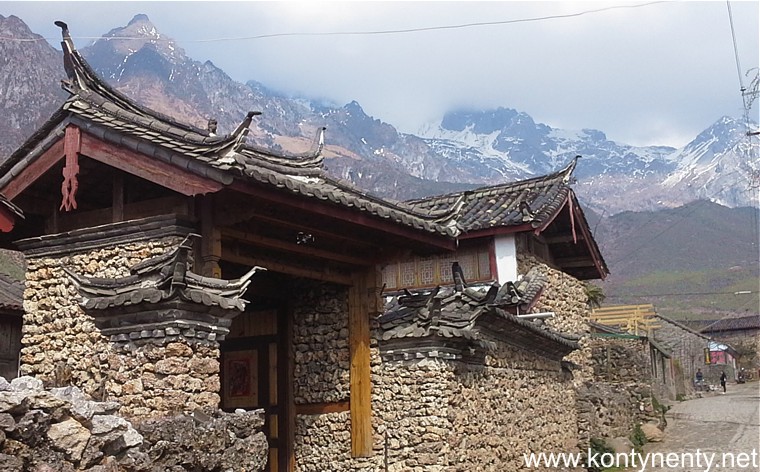
Europeans traveling alone through China does not have an easy life - primarily due to difficulties in communication with the Chinese. But that does not mean that that I have there pleasant meetings and interesting discussions. Here, for example, a group of employees of the bank, I met them in Tibetan monastery. Together, we conducted the action "Cleaning the world". There were a lot to clean around:
Europejczyk podróżujący samotnie przez Chiny nie ma łatwego życia - przede wszystkim ze względu na trudności w porozumiewaniu się z Chińczykami. Ale nie znaczy to, że że nie miałem tam miłych spotkań i ciekawych dyskusji. Tu na przykład wycieczka pracowników banku, którą spotkałem w tybetańskim klasztorze. Wspólnie przeprowadziliśmy akcję "sprzątanie świata":
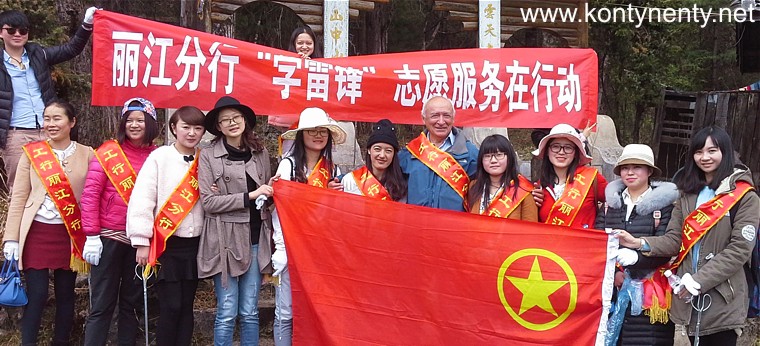
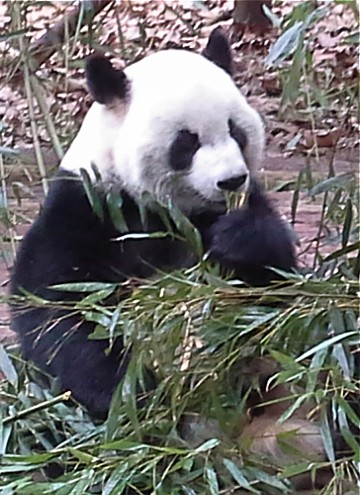
Then, to warm up, I planed a week's stay on the islands scattered along the east coast of Malaysia. The first of these islands was Tioman, which surprised me with high, green mountains and the fact that the island has so poorly developed infrastructure. Path leading through the mountainous jungle took me to the charming village Juara on the east side of the island (pictured below). More about Tioman you will find on my TIOMAN web page.
Ostatnim miastem które odwiedziłem tego roku w Chinach było Chengdu. Na peryferiach tego wielkiego miasta znajduje się największy w Chinach (i świecie) rezerwat wielkich pand. Bardzo chciałem zobaczyć to miejsce. Trzeba tam być wczesnym rankiem, bo później najedzone pandy układają się do snu. Widowisko jest niesamowite, bo te rzadkie niedźwiedzie potrafią być bardzo zabawne. Jest ich tam kilkadziesiąt. A oprócz wielkich pand - także znacznie mniejsze i przypominające raczej lisy - pandy czerwone.
The last city visited in China was Chengdu. On the outskirts of this great city is the largest in China (and in the world) reserve of great pandas. I really wanted to see this place. You have to be there early in the morning, because later sated pandas put to sleep. The show is amazing, because these rare bears can be very funny. There are dozens of them.
Aby się potem ogrzać zaplanowałem na koniec tydzień pobytu na wyspach rozsianych wzdłuż wschodniego wybrzeża Malezji. Pierwszą z tych wysp był Tioman, gdzie zaskoczyły mnie wysokie, zielone góry i fakt, że wyspa ma tak słabo rozwiniętą infrastrukturę. Ścieżką wiodącą przez górską dżunglę wędrowałem do uroczej osady Juara po wschodniej stronie wyspy (na zdjęciu poniżej). Okazało się, że zaniedbany Tioman jest strefą wolnocłową, gdzie po rozsądnej cenie można kupić rum i rozkoszować się moim ulubionym "rumem w papai" O Tiomanie napisałem już obszernie na osobnej stronie TIOMAN.
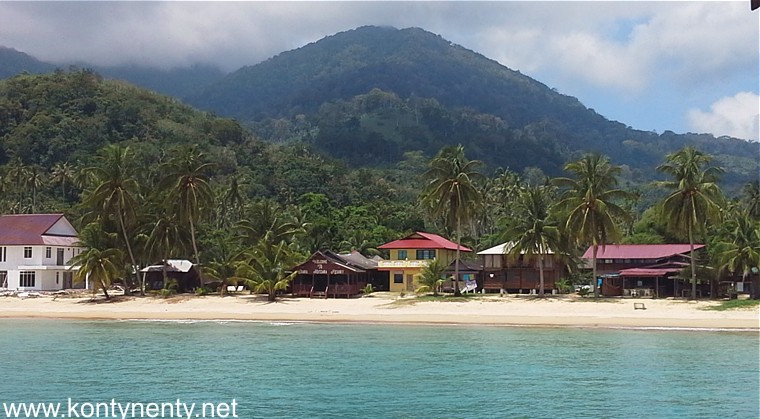
From Tioman I returned back to the mainland and drove away by bus to the north of Malaysia to find a little and bumpy speedboat for two small, beautiful island called the Perhentian Islands. I was afraid that at the beginning of March will not be there overturn the remnants of the monsoon, but not - the weather was fine, and hiking allowed me to appreciate the beauty of this corner of Asia:
Z Tiomanu wróciłem z powrotem na kontynent i jechałem dalej autobusami na północ Malezji, by dotrzeć podskakującą na falach niewielką łodzią motorową na dwie małe, piękne wyspy nazywane Perhentian Islands. Obawiałem się, czy aby na początku marca nie będą się tam przewalać ostatki monsunu, ale nie - pogoda dopisała, a piesze wędrówki po obu wyspach pozwoliły mi docenić urodę tego zakątka Azji:
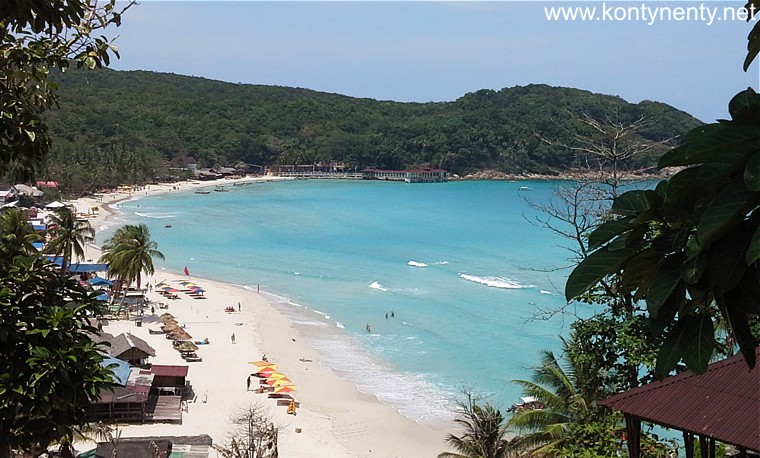
My complete report from these paradise islands you will find here. From Malaysia via Istanbul and Warsaw I safely returned home. Another great trip was completed. It's time now for the arranging the whole material brought from the journey - a few thousand of photos and several hours of video. Certainly new, more comprehensive web pages will appear on my website.
Mój kompletny raport z tych rajskich wysepek znajdziecie na osobnej stronie PERHENTIAN. Z Malezji przez Istambuł i Warszawę wróciłem szczęśliwie do domu. Jeszcze jedna wielka podróż została pomyślnie zrealizowana. Przyjdzie zapewne pora na opracowanie przywiezionego materiału - kilku tysięcy zdjęć i kilkunastu godzin filmu. Będą z tego na pewno nowe, obszerniejsze strony w internecie.
In Romania I was the last time in 1973, 43 years ago! Then I wandered through the monasteries of Bukovina to Bucharest. I came to the conclusion that a network of cheap airlines well developed in Europe provides excellent opportunities for low-cost exploration of this part of Romania, which I do not know yet - Transylvania - and set off on a short trip. It began with the flight via Malmo to the Hungarian Debrecen, lying next to the Romanian border:
W Rumunii byłem po raz ostatni w 1973 roku, 43 lata temu! Wędrowałem wtedy przez klasztory Bukowiny i Bukareszt. Doszedłem do wniosku, że rozbudowana w Europie sieć tanich linii lotniczych daje doskonałe możliwości do taniego eksplorowania tej części Rumunii, której nie znam - Transylwanii i wyruszyłem w krótką podróż. Zaczęła się ona od lotu przez szwedzkie Malmo do węgierskiego Debreczyna, leżącego tuż przy rumuńskiej granicy:
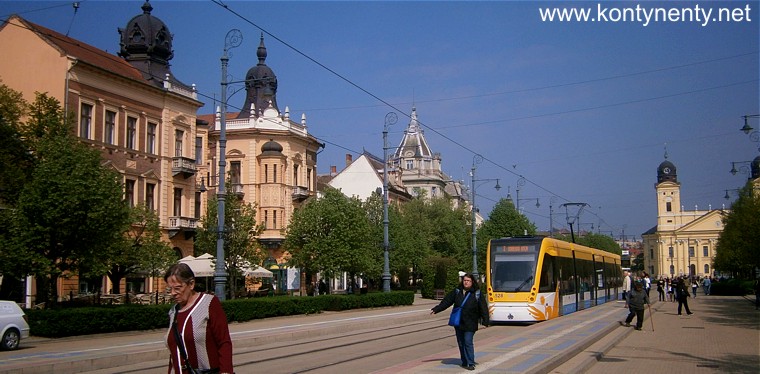
I crossed the border by bus to just half an hour later I found myself in Oradea. The central square of the city - Uniri - has been beautifully restored (on the picture below). In the Transylvania lives large community of Hungarians. Hungarian language is heard on the streets. And I lived in Oradea in a stylish, old Hungarian tavern - the so-called csarda
Granicę węgiersko - rumuńską przekroczyłem autobusem, by zaledwie pół godziny później znaleźć się w Oradei. Centralny plac tego miasta - Uniri - został pięknie odrestaurowany na zdjęciu poniżej). W Transylwanii mieszka liczna społeczność Węgrów. Język węgierski słyszy się na ulicach. A ja mieszkałem w Oradei w stylowej, starej węgierskiej gospodzie - tzw. csardzie...
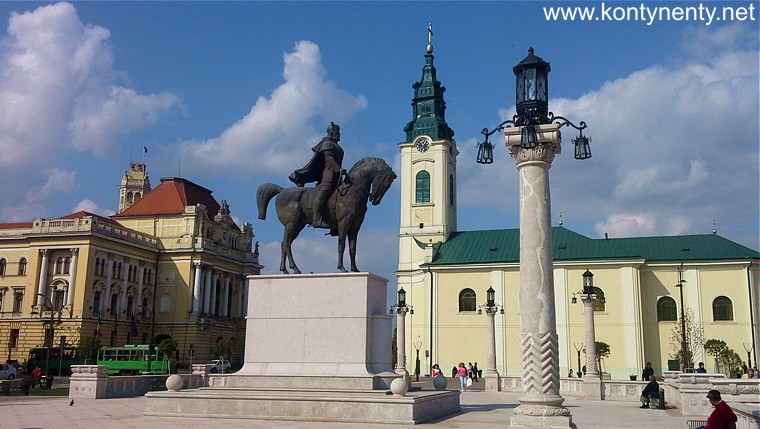
Bus transport in Romania is not expensive, but fragmented into many private companies. I have found a good website where you can check all the possible ride combinations, including the railway: www.autogari.ro
By another bus I drove to the Cluj-Napoca - city of Roman origin. Here, too, the most representative is the main Uniri Square- or simply old-town square with a big Catholic church. In Cluj I found polonica: traces of Josef Bem and Stefan Batory.
Komunikacja autobusowa w Rumunii nie jest droga, ale rozdrobniona na wiele prywatnych firm. Odkryłem dobrą stronę, na której można sprawdzać wszystkie możliwe połączenia, także kolejowe: www.autogari.ro
Kolejnym autobusem pojechałem do Kluża (Cluj-Napoca) - miasta z rzymskim rodowodem. Tu także najbardziej reprezentacyjny jest główny plac Uniri - czyli po prostu staromiejski rynek z wielkim kościołem katolickim. W Klużu znalazłem polonica: ślady Józefa Bema i Stefana Batorego.
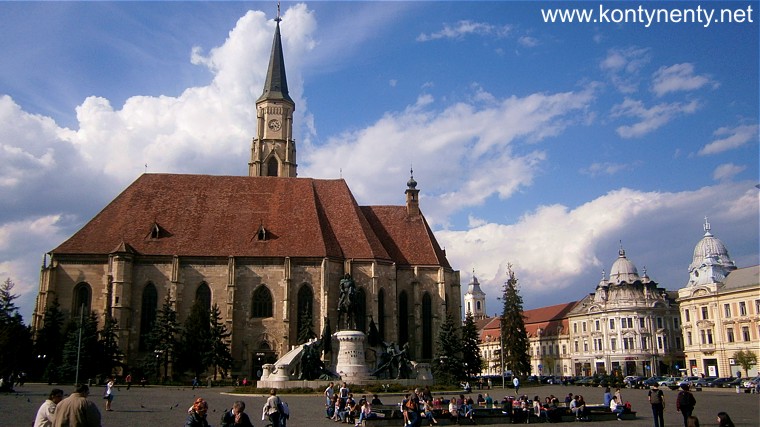
The next city on my route was Sibiu. Sibiu has probably the most beautiful in Romania complex of buildings of the Old Town. But I also admired built on the outskirts of the city open-air museum of wooden rural constructions. It is located in a very nice area. All the time on the route I had great spring, sunny weather, which allowed me to take interesting pictures:
Następnym miastem na moim szlaku był Sybin (Sibiu). Sybin ma chyba najpiękniejszy w Rumunii zespół budowli Starego Miasta. Ale ja podziwiałem także zbudowany pod miastem w bardzo ładnej okolicy skansen drewnianego budownictwa wiejskiego. Cały czas towarzyszyła mi wspaniała wiosenna, słoneczna pogoda, co pozwalało mi robić ciekawe zdjęcia:
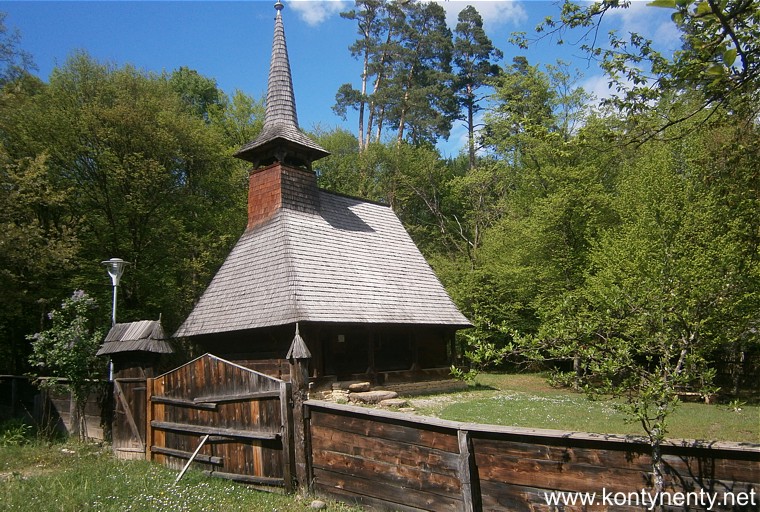
From Sibiu I went to another Romanian city founded by the Romans: Alba Iulia. I found there a great citadel built at a time when Transylvania belonged to the Austro-Hungarian Empire. On the wide grounds of the citadel there are two cathedrals: the Catholic and Orthodox, luxury hotel, university, museum and even a military unit. Not surprisingly, they does not charge any admission fees here. In other places, where such charges were collect I used the discounts for seniors, Romanians apparently respect them...
Z Sibiu pojechałem do kolejnego rumuńskiego miasta założonego przez Rzymian: Alba Iulia. Znalazłem tam wielką cytadelę wybudowaną w czasach, gdy Transylwania należała do cesarstwa Austro-Węgierskiego. Na rozległym terenie cytadeli stoją dwie katedry: katolicka i prawosławna, luksusowy hotel, uniwersytet, muzeum i jeszcze jednostka wojskowa. Nic dziwnego, że za wstęp nie pobiera się tu żadnych opłat. W innych miejscach, gdzie takie opłaty pobierają korzystałem ze zniżek dla seniorów, których Rumuni najwyraźniej bardzo szanują...
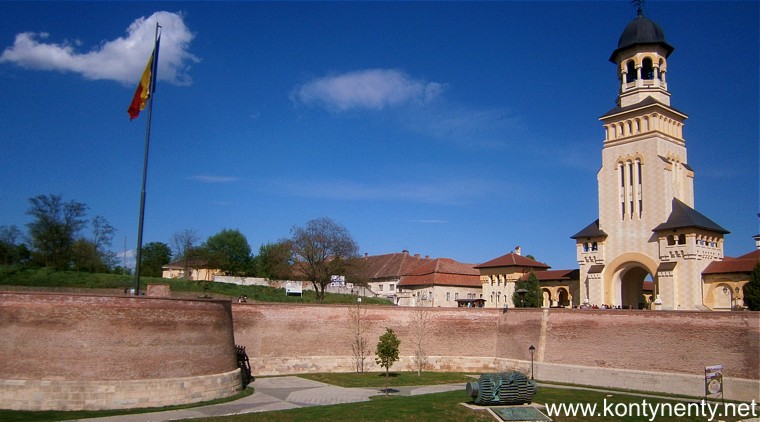
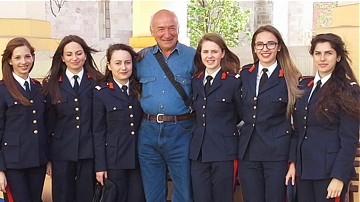
Na terenie cytadeli w Alba spotkałem grupę dziewcząt ze szkoły wojskowej. Byłem mile zaskoczony, bo mówiły po angielsku. Było dużo śmiechu...
Na zdjęciu poniżej główny budynek prawosławnej katedry:
Within the citadel of Alba I met a group of girls from military school. I was pleasantly surprised because they spoke English. There was a lot of laugh...
On the picture on the right column you
can enjoy the view of the main building of the Orthodox Cathedral.
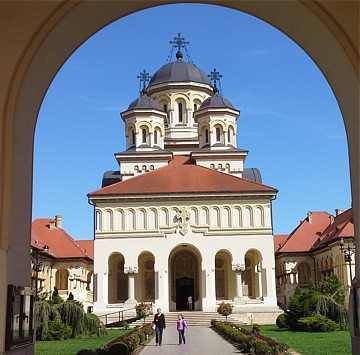
In the guidebooks they write that the most beautiful Gothic castle Romania is Corvin Castle in Hunedoara. Hunedoara itself does not impress me - it is an industrial city.
But the castle, built on the outskirts of the city is very charming. I visited him "from the march" - a small backpack allowed me to move effortlessly from town to town and visit various interesting objects along the way:
W przewodnikach piszą, że najpiękniejszym zamkiem gotyckim Rumunii jest Corvin Castle w miejscowości Hunedoara. Sama Hunedoara nie zachwyca - jest to bowiem miasto przemysłowe. Ale zamek zbudowany na peryferiach miasta jest bardzo urokliwy. Zwiedzałem go "z marszu" - mały plecak pozwalał mi przemieszczać się bez większego wysiłku od miasta do miasta i odwiedzać różne ciekawe obiekty po drodze:
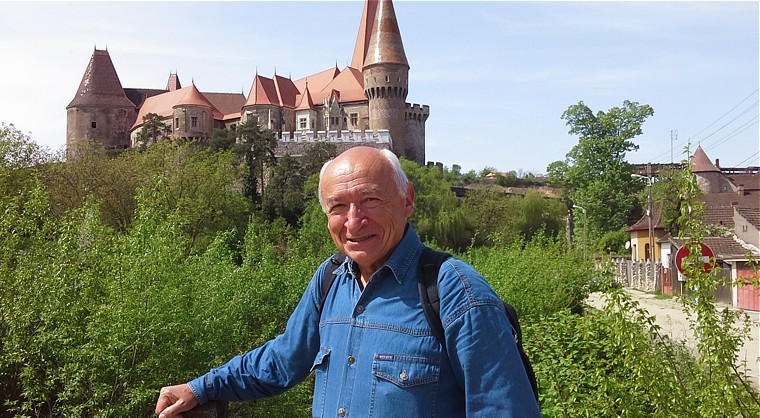
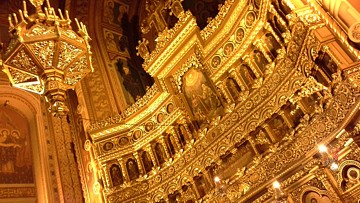
Ostatnim rumuńskim miastem na moim szlaku była Timisoara - kolebka rumuńskiej rewolucji, gdzie w licznych pięknych parkach kwitły już wiosenne kwiaty, a w prawosławnej katedrze podziwiałem najpiękniejszy chyba na Bałkanach ikonostas (na zdjęciu obok).
Podczas mojej podróży w kilku miejscach spotykałem podróżników z międzynarodowych organizacji. Także tu - Timisoarze gościł mnie wyjątkowy człowiek - Sorin (na zdjęciu poniżej). Pokazał mi swoje miasto i odwiózł na lotnisko. Ale jeszcze przedtem przegadaliśmy wspólnie wiele godzin, oglądając zdjęcia i filmy z dalekiego świata. Bardzo mile wspominam to spotkanie...
The last Romanian city on my route was Timisoara - the cradle of the
Romanian revolution, where many beautiful parks already bloomed in spring
flowers, and in the Orthodox cathedral I admired the most beautiful
iconostasis in the Balkans (see picture above).
During my trip in several places I encountered travelers from international
organizations. Also here - in Timisoara an exceptional man hosted me -
Sorin (pictured on the right column). He showed me his city and then drove
to the airport. But before we talked for many hours watching together the
photos and videos from a distant world. I recall this meeting very
pleasantly...
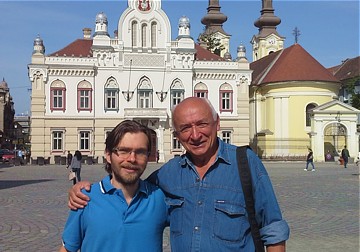
From Timisoara via Dortmund I returned to Gdansk, spending for both flight less than 100 zlotys. It was a short, but successful and at the same time a very interesting journey. Development of the routes of low-cost airlines will allow me probably another short trips in this style.
Z Timisoary przez Dortmund wróciłem do Gdańska wydając na ten przelot poniżej 100 złotych. To była krótka, ale udana i przy tym bardzo ciekawa podróż. Szybki rozwój tras tanich linii lotniczych umożliwi mi zapewne kolejne krótkie wypady w takim stylu.
In May 2016 I completed another European trip! Using
flights of low-cost airlines, I managed to visit our eastern neighbors -
Lithuania and Ukraine. In Lithuania, I was 30 years ago, and Kiev I saw 40
years ago ... In those days you could not move freely in the Soviet
republics. Duration of stay was also limited. These were the times of
black-and-white photograph, which we often forget. Eastern Europe from
Soviet times had changed, so I get there to know her again. The first city
on my route was the Lithuanian Kaunas, which can boast of beautiful old
town:
W maju 2016 roku odbyłem kolejną europejską podróż! Wykorzystując loty tanich linii udało mi się odwiedzić naszych wschodnich sąsiadów - Litwę i Ukrainę. Na Litwie nie byłem od 30 lat, a Kijów oglądałem 40 lat temu... W tamtych czasach nie można było swobodnie poruszać się po radzieckich republikach, czas pobytu też był ograniczony. Były to jeszcze czasy czarno-białej fotografii, o czym często zapominamy. Wschodnia Europa od czasów Związku Radzieckiego bardzo się zmieniła, poznawałem ją na nowo. Pierwszym miastem na moim szlaku było litewskie Kowno, mogące się pochwalić piękną starówką:
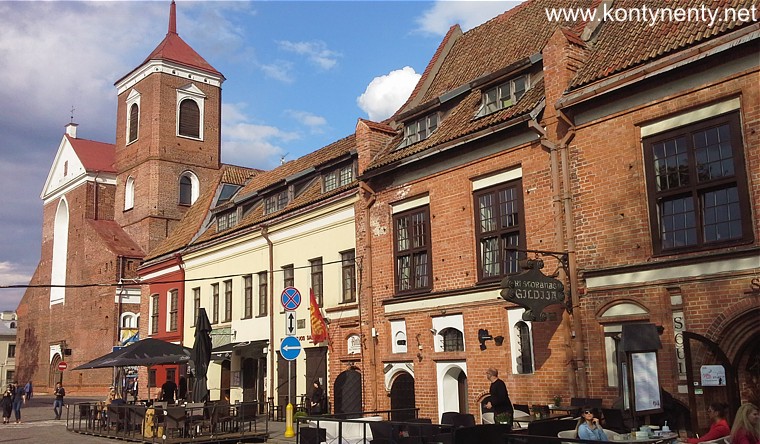
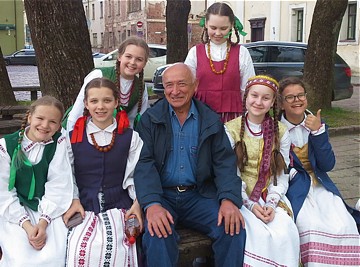
Jak zawsze chciałem nie tylko zwiedzać, ale także spotykać nowych przyjaciół. Pierwsze takie spotkanie - z dziewczętami z regionalnego zespołu miało miejsce na kowieńskim rynku,
As always I wanted to not only see the places of interest, but also to meet new friends. The first such meeting - with the girls from the regional folk team took place at Kaunas market.
Następnego dnia wynająłem mały samochód i pojechałem do historycznego miasteczka Kiejdany, gdzie przed ratuszem zwraca uwagę pomnik księcia Janusza Radziwiłła:
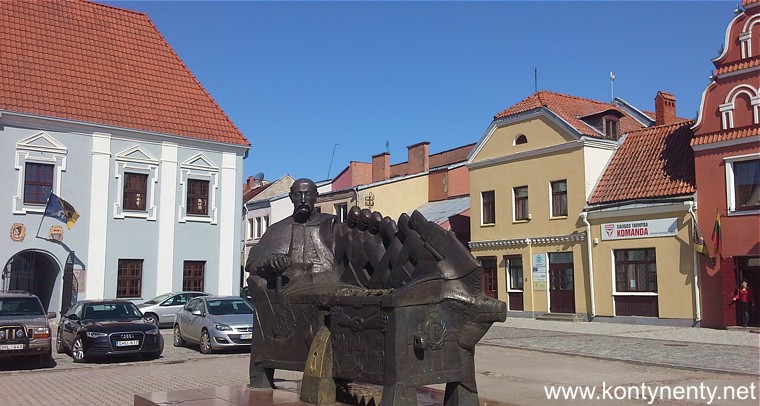
Later that same day I was able to visit the famous Hill of the Crosses - one of the most unique places in Lithuania. Pilgrims come here from Lithuania and Europe, bring here the crosses of different size and shape:
Jeszcze tego samego dnia udało mi się odwiedzić słynną Gorę Krzyży - jedno z najbardziej niezwykłych miejsc na Litwie. Pielgrzymi przybywający tu z Litwy i Europy przynoszą tu krzyże różnej wielkości i kształtu. Niestety w sezonie turystycznym więcej tu wycieczek niż pielgrzymów:
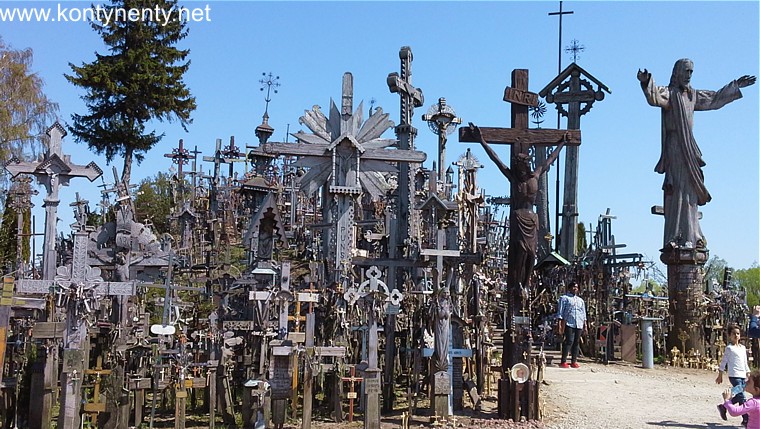
The car rented even for 24 hours only gives you the opportunity to visit many places. Before sunset I reached the most beautiful castle in Lithuania built on a lake in Trakai:
Samochód wypożyczony nawet na 24 godziny daje możliwość odwiedzenia wielu miejsc. Przed zachodem słońca jeszcze ego pierwszego dnia jazdy dotarłem do najpiękniejszego zamku Litwy, zbudowanego na jeziorze w Trokach:

Samochód oddałem na lotnisku w Wilnie, by skorzystać z kolejnego taniego lotu, który przeniósł mnie do Kijowa. Zamieszkałem tam w mini-hotelu w centrum miasta - z widokiem na dachy stolicy i kijowska operę. Do słynnego Majdanu (na zdjęciu poniżej) miałem 20 minut spaceru.
I returned the car at the airport in Vilnius, to take advantage of another cheap flight which brought me to Kiev. I lived there in a mini-hotel in the city center - overlooking the rooftops of the capital city and Kyiv opera. The famous Majdan - Independence Square (pictured below) had a 20 minutes walk.
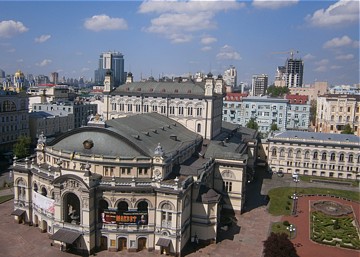
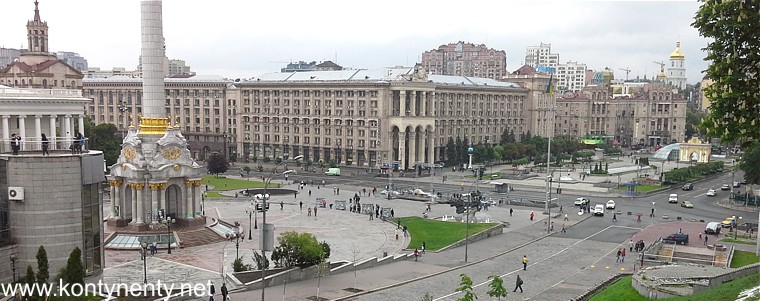
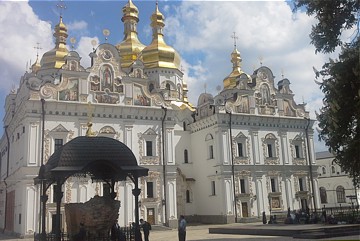
Wielkie wrażenie zrobiła na mnie odrestaurowana Kijowska Ławra ( na zdjęciu obok). Przyjaciele z międzynarodowej organizacji Servas - Irina i Sasza pokazali mi w Kijowie miejsca nie tylko dobrze znane turystom, ale także te, które są rzadko odwiedzane. Po degustacji znakomitego ukraińskiego barszczu pokazywałem im zdjęcia i filmy ze świata.
Big impressed me restored Kiev Lavra (big orthodox monastery -pictured left). Friends from international organization Servas - Irina and Sasha showed me a places in Kiev not only well known to tourists, but also those that are rarely visited. After tasting the excellent Ukrainian borscht I showed them photos and videos from the world.
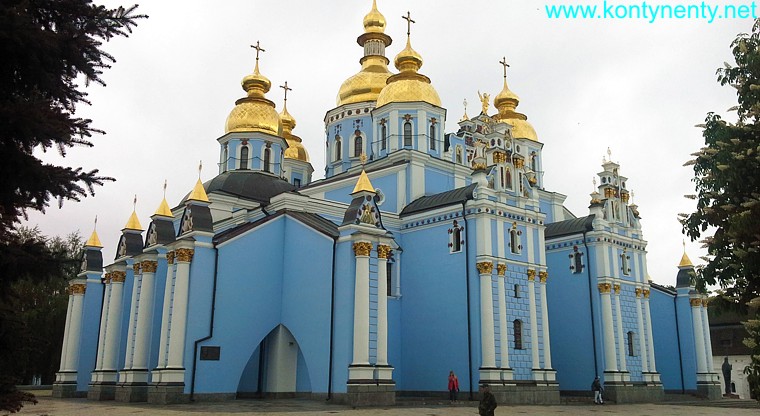
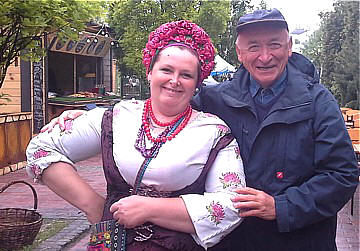
Na placu przed Michajłowskim Soborem, którego złote kopuły są widoczne z daleka trwał jeszcze wielkanocny kiermasz wyrobów ludowych i narodowych potraw. W kramach urzędowały dziewczyny w ludowych strojach. Była to świetna okazja nie tylko do rozmów, ale i do wspólnych zdjęć...
On the square in front of the Mikhailovsky Sobor, whose golden domes can be seen from afar lasted still the Easter fair offering of folk souvenirs and national dishes. The stalls I found girls in folk costumes. It was a great opportunity not only to talk, but also to the common pictures...
After returning to Vilnius I had time to thoroughly explore this beautiful city, which boasts Europe's largest Old Town. Very nice looks vast Cathedral Square:
Po powrocie do Wilna miałem czas, by dokładnie zwiedzić to piękne miasto, które szczyci się największą w Europie Starówką. Bardzo efektownie wygląda dziś rozległy Plac Katedralny:

Na placu przed Uniwersytetem Stefana Batorego spotkałem dziwnym zbiegiem okoliczności Litwina Viliusa, z którym 5 lat temu przemierzyłem spory fragment egipskiej Sahary. A potem przed pałacem prezydenckim podziwiałem eleganckie uniformy prezydenckiej gwardii.
On the square in front of the University of Stefan Batory I met by strange coincidence Lithuanian - Vilius, 5 years ago we traveled together the section of the Egyptian Sahara. And later in front of the presidential palace I admired the elegant uniforms of the presidential guards.
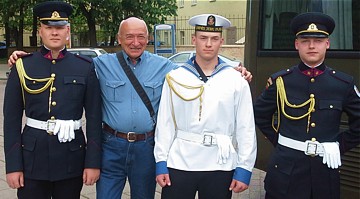
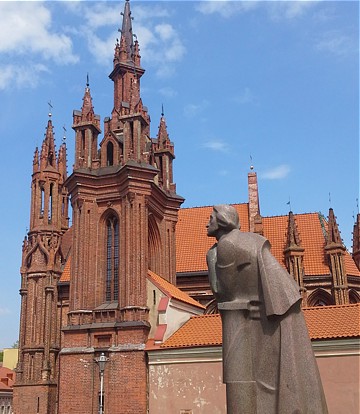
Był piękny wiosenny czas - kwitły bzy i kasztanowce. W Wilnie znalazłem wiele polskich śladów - w tym niezbyt udany pomnik Adama Mickiewicza obok pięknego kościoła Św. Anny. W Instytucie Polskim miałem wykład połączony z pokazem przeźroczy o moich podróżach przez świat. Sala była pełna. A sprawozdanie z tego spotkania możecie znaleźć tutaj.
It was a beautiful spring time - lilacs and chestnut trees were blooming. In Vilnius I found many Polish traces - including the not very successful monument of our great poet Adam Mickiewicz next to the beautiful church of St. Anne. In The Polish Institute in Vilnius I had a lecture and a slide show about my travels around the world. The room was full. A report of this meeting can be found here.
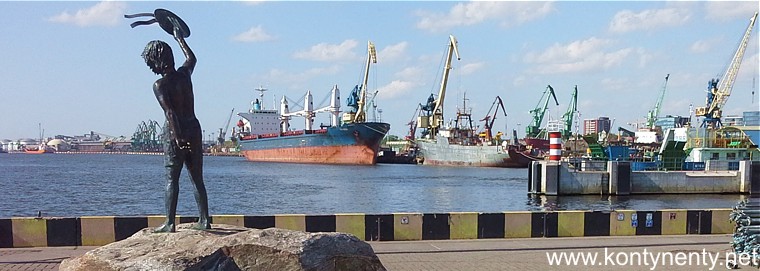
This voyage also allowed me to reach new, completely unknown places. Her final touch was a visit to the Lithuanian Baltic coast: the large port of Klaipeda and Palanga with its nice Amber Museum. I came back with a collection of interesting pictures and conviction that even just across the border, you can find interesting world and nice people.
Ta podróż pozwoliła mi także dotrzeć do nowych, zupełnie nieznanych miejsc. Jej końcowym akcentem było zwiedzanie litewskiego wybrzeża Bałtyku: dużego portu Kłajpeda i Połągi z jej ciekawym Muzeum Bursztynu. Wróciłem z kolekcją ciekawych zdjęć i przekonaniem, że nawet tuż za miedzą można znaleźć interesujący świat i miłych ludzi.
In September 2016 I returned from the interesting voyage to the Far North! Summer was not over yet, when I already started a new journey. This is because the route took me to the Polar Circle, where even in the summer is cool, and later, when it comes the beginning of autumn snowfalls appears. Adventure began in Omsk in Western Siberia, where in the summer, every two or three weeks river boats are departing to the north. Unfortunately, I was not able to buy a ticket for the first segment of the cruise and had to chase the ship... by train - in the next stop in Tobolsk. The map of this voyage you can see here.
In Omsk what surprises tourists is nicely restored old street, full of old merchants' mansions. It bears the name of ... Vladimir Lenin. It was still warm when I was there:
We wrześniu 2016 roku wróciłem z ciekawej ekspedycji na Daleką Północ! Lato jeszcze trwało, gdy wyruszałem w tę samotną podróż. A to dlatego, że jej trasa prowadziła aż za Krąg Polarny, gdzie nawet latem jest chłodno, a później, gdy przychodzi początek jesieni pojawiają się opady śniegu. Moja podróżnicza przygoda rozpoczęła się w Omsku na Zachodniej Syberii, skąd latem, średnio co dwa, trzy tygodnie wyruszają rzeczne statki płynące na północ. Niestety, nie udało mi się dostać biletu na pierwszy segment rejsu i musiałem gonić statek... pociągiem - do następnego miejsca postoju w Tobolsku. Mapkę podróży możecie zobaczyć tutaj.
W Omsku zaskakuje turystów ładnie odrestaurowana, stara ulica, pełna dawnych kupieckich rezydencji. Nosi ona imię... Włodzimierza Lenina. Tu jeszcze było ciepło:
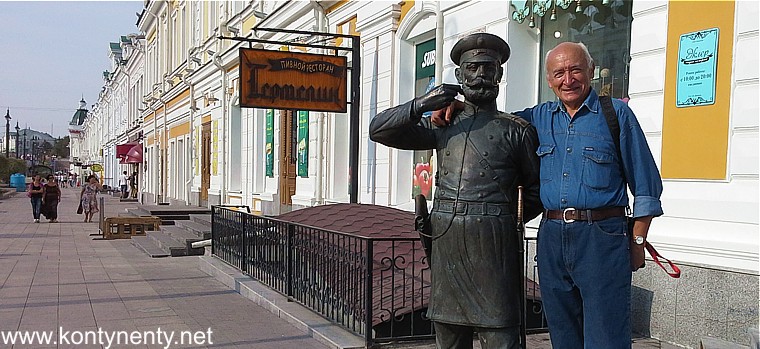
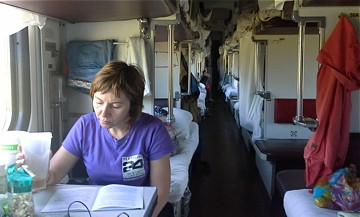
Tak więc, po krótkim wypoczynku wsiadłem rano w Omsku do wagonu klasy "płackartny" (na zdjęciu obok), przypominającego naszą kuszetkę, tyle że nie ma tu zamykanych przedziałów i wszyscy wszystko widzą. W cenę biletu jest automatycznie wliczony komplet pościeli i mini - ręcznik. Wieczorem byłem już w zabytkowym Tobolsku (zdjęcie poniżej).
After a short relax I boarded in Omsk the train. I was travelling in the third class called "platskartny" (picture on the left column) Little privacy there but the sheets and mini-towel are included in the ticket price. In the evening I was already in historic city of Tobolsk:
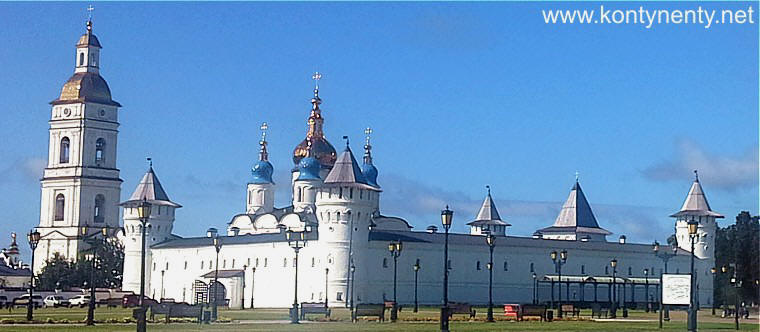
In Tobolsk my lovely friend Alla was waiting for me with the boat ticket. On the next day I embarked an old, 60-year-old ship "Rodina" and sailed down the Irtysh and Ob rivers to the city of Salehard, lying on the Arctic Circle. It was many days and nights spent in a cramped cabin with bunk berths. But the trip also gave the opportunity to talk with fellow passengers, to observe the passing scenery and to explore the riverside villages during short stops. Look below at our "Rodina", carrying in theory 192 passengers and - in practice - taking aboard everyone from passing riverside settlements, which are not accessible by any other transport:
W Tobolsku czekała na mnie z biletem sympatyczna Rosjanka - Ałła. Wsiadłem tam na stary, 60-letni statek "Rodina" i popłynąłem nim Irtyszem i Obem aż do miasta Salechard, leżącego na Kole Podbiegunowym. To było wiele dni i nocy, spędzonych w ciasnej kajucie z piętrowymi kojami. Ale taki rejs dawał także okazję do rozmów ze współpasażerami (byłem na pokładzie jedynym cudzoziemcem), do obserwacji mijanych krajobrazów i do zwiedzania nadrzecznych miejscowości podczas krótkich postojów. Tak wyglądała nasza "Rodina", zabierająca teoretycznie 192 pasażerów, a w praktyce - wszystkich chętnych z mijanych nadrzecznych osad, do których nie dociera żaden inny transport:
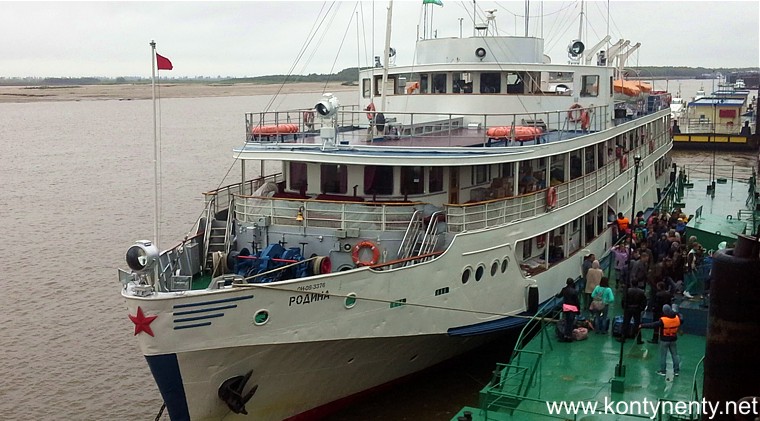
Pogoda na początku była bardzo kapryśna, czasem padało, krajobrazy zmieniały się każdego dnia: płynęliśmy przez tajgę, przez małe przełomy, a potem przez obszary tundry. W Salechardzie czekała na mnie na przystani Katia - pojechaliśmy po pofalowanej na wiecznej zmarzlinie drodze do jej domu na barszcz i surową syberyjską rybę...
Weather at the beginning was very capricious, sometimes it was raining, landscapes changed every day: we sailed through the taiga, the small breakthroughs, then the areas of tundra. In Salekhard Katya was waiting for me at the jetty - she drove me the undulated on permafrost way to her home for the borscht and raw Siberian fish ...
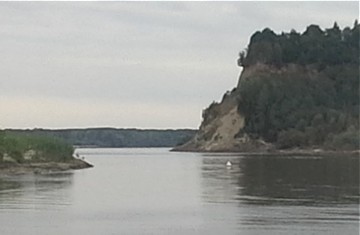
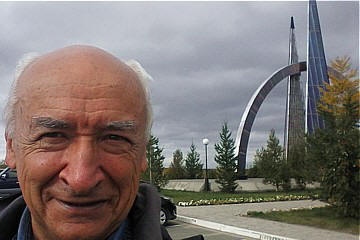
Salechard cieszy oczy nowymi domami zbudowanymi za pieniądze ze sprzedaży gazu - bogactwa Jamału. Będąc tam wypada sfotografować się przy pomniku ustawionym na Kręgu Polarnym (zdjęcie obok). Z Salechardu kolejnym statkiem "Kałasznikow" popłynąłem jeszcze dalej na północ - do regionów zamieszkanych przez Neńców.
Salekhard has new houses built with the money from the sale of gas. While you are there it is obligatory to take photograph in front of the monument set to the Arctic Circle (photo). From Salekhard another ship, "Kalashnikov" sailed me further north - to the regions inhabited by Nenets tribe.
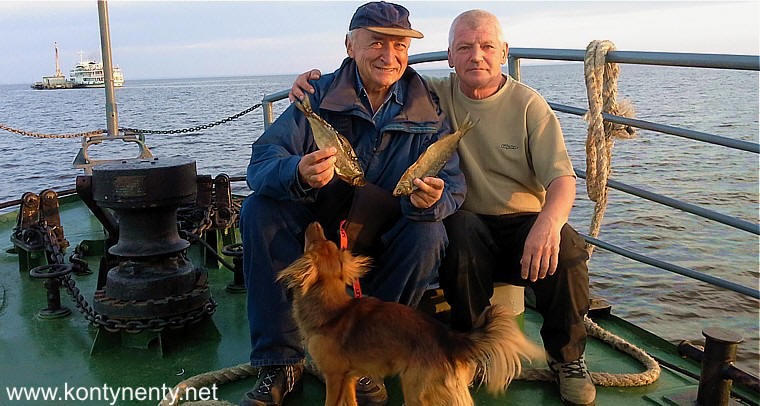
The Russians were very nice to me, they offered me fish as a gift (as pictured above), invited to have the tea and common photograps. In the northernmost settlement, to which I arrived - Antipayuta (about 67 degrees North, 67 degrees East) Nenets locals invited me to his house-tent - chum (picture below).
Rosjanie byli dla mnie bardzo mili, byłem obdarowywany rybami (jak na zdjęciu powyżej), częstowany herbatą, fotografowany. W najbardziej wysuniętej na północ osadzie, do której dotarłem - Antipajuta (około 67 stopni North, 67 stopni East) miejscowi Neńcy zaprosili mnie do swojego domu-namiotu - czumu (zdjęcie poniżej).
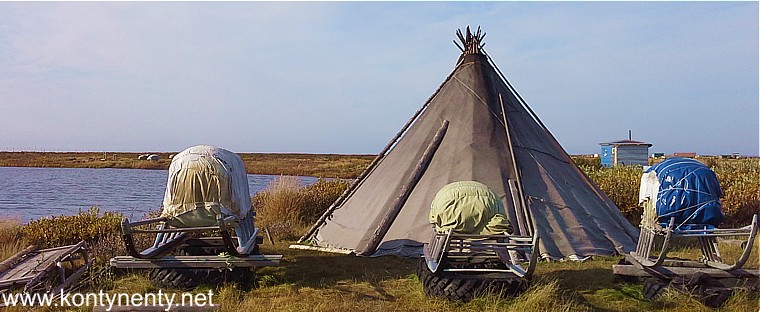
Locals claimed that it was an exceptionally warm September. There was no snow. The sun was shining and I could fully appreciate the beauty of the local raw nature. Tundra of the north consists not only of the land areas, there are as well nice, scenic rivers:
Miejscowi - Rosjanie i Neńcy - twierdzili, że był to wyjątkowo ciepły wrzesień. Nie było śniegu. Świeciło słońce, a ja dzięki temu mogłem w pełni docenić urodę tamtejszej surowej przyrody. Tundra - jak mogłem się przekonać - to nie tylko obszary lądowe, ale także malownicze rzeki:
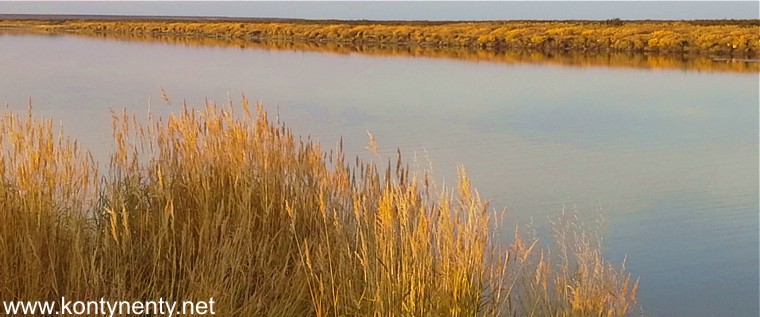
In Antipayuta we anchored just on such a river, and passengers, due to the lack of harbor were brought ashore in the longboat. When we set out after sunset starting the way back to Salekhard polar sky was on fire:
W Antipajucie kotwiczyliśmy właśnie na takiej rzece, a pasażerowie, ze względu na brak przystani dowożeni byli na ląd szalupą. Gdy po zachodzie słońca wyruszyliśmy w powrotną drogę do Salechardu polarne niebo dosłownie płonęło:
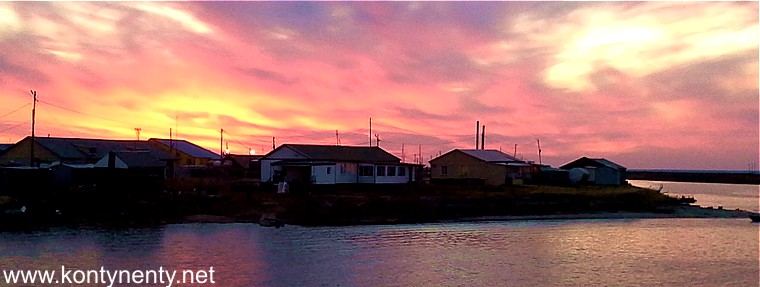
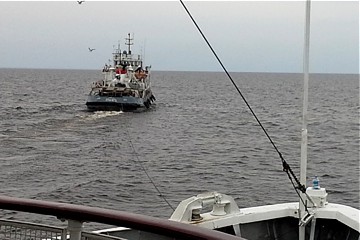
Następnego dnia nasz 61-letni "Kałasznikow" się popsuł. Kotwiczyliśmy przez kilka godzin w pobliżu nagiego i pustego wybrzeża czekając na pomoc. Na szczęście radio działało i jeszcze tego samego dnia pojawił się holownik. Rzucono stalową linę i ponad półtorej doby holowano nas do Salehardu. Tam przeprawiłem się przez szeroko rozlany Ob i polarną linią kolejową przez malowniczy Polarny Ural (zdjęcie poniżej) jechałem dalej do Workuty - miasta, do którego nie doprowadzono dotąd żadnej drogi.
On the next day, our 61-year-old "Kalashnikov" broke down. We anchored for several hours in the vicinity of naked and empty coast waiting for help. Fortunately, the radio worked, and on the same day the tug came. Steel wire rope was thrown and the tugs over one and a half days towed us to Salekhard. There I crossed the wide Ob river by ferry and used polar railway line through the picturesque Polar Ural Mts (picture below) going to Vorkuta - a city which still has not any road access.
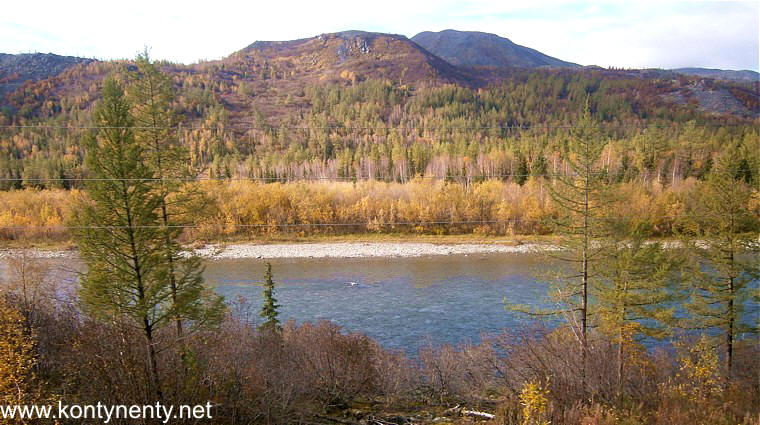
Vorkuta, mining town built in the times of Stalinism north of the Polar Circle has a very sad story. Forcibly deported Poles worked there for many years . It commemorates a huge cross, placed at the entrance to an abandoned village Rudnik:
Workuta - zbudowane w czasach stalinizmu za Kręgiem Polarnym górnicze miasto ma bardzo smutną historię. Pracowali tam przymusowo przez wiele lat deportowani Polacy. Upamiętnia to wielki krzyż, postawiony u wjazdu do opuszczonej osady Rudnik:
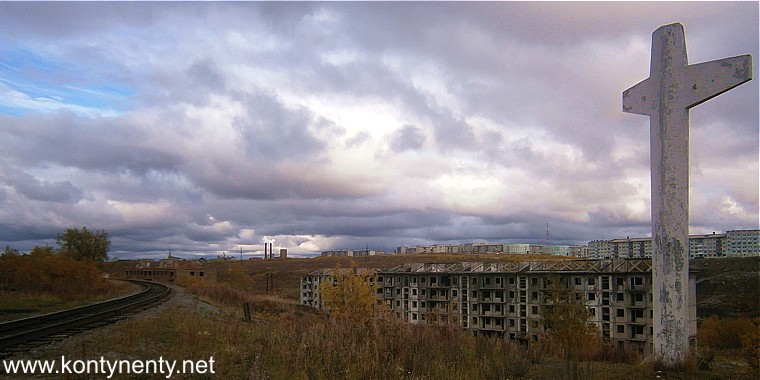
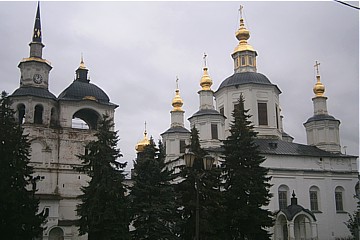
Następnym przystankiem na mojej kolejowej trasie było historyczne, ale mało znane turystom miasto Wielki Ustiug, położone nad szeroko rozlaną Północną Dźwiną. Miasto rozkwitało w XVII wieku, bogacąc się na handlu. Wzniesiono wtedy w Ustiugu aż 27 cerkwi i 4 klasztory. Wiele z nich przetrwało do dziś...
The next stop on my train route was historic but little-known town of Veliky Ustyug, located on the widely diffused Northern Dvina. The city flourished in the seventeenth century, enriching themselves on the trade. Then they built there in Ustiug 27 orthodox churches and 4 monasteries. Many of them have survived till now...
Ostatnim miastem na moim północnym szlaku był Archangielsk - metropolia, która aspiruje do miana stolicy Rosyjskiej Północy. W Archangielsku jest co zwiedzać - budują tam między innymi wielki sobór Michała Archanioła, od którego nazwę wzięło miasto. Jego kopuły widzicie na zdjęciu obok. Na przedmieściach Archangielska jest ciekawy skansen drewnianego budownictwa. Spotkałem tam także sympatyczne przewodniczki w narodowych rosyjskich strojach - popatrzcie na zdjęcie poniżej :)
The last town on my "northern" route was the Arkhangelsk - metropolis, which aspires to become the capital of the Russian North. The Arkhangelsk there is a lot to see - they build there, among others, the great church of Archangel Michael, from which they took the name of the city. In the suburbs of Arkhangelsk there is an interesting open-air museum of wooden buildings. I met there a pretty guide in Russian national costume - look at the picture below :)
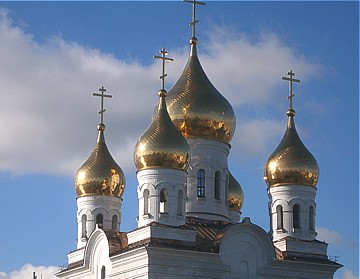
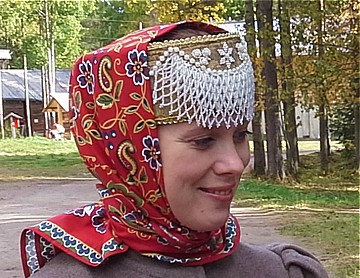
Nie było wcale łatwo przygotować taką pionierską ekspedycję. Była to jeszcze jedna ciekawa podróż - do rejonów w których jeszcze nie byłem. Podróż oceniam jako udaną - również dlatego, że pogoda była nadspodziewanie dobra i że spotkałem po drodze wielu życzliwych ludzi. Dziękuję tym spośród was, którzy trzymali za mnie kciuki! :) Krótkie wiadomości z tej trasy znajdziecie też w moim dzienniku podróży.
It was not easy at all to prepare such a pioneering expedition. It was another interesting trip - to the areas in which I have not been yet. The voyage was successful - also because the weather was surprisingly good. Thank you to those of you who kept fingers crossed for me! :) Short messages in English from this route you can find in my travel log.
|
Travel snapshots from recent years --- Migawki z podróży ostatnich lat |
||||
| Podróże roku 2014 | Podróże roku 2013 | Podróże roku 2010-2012 | Podróże roku 2009- | |